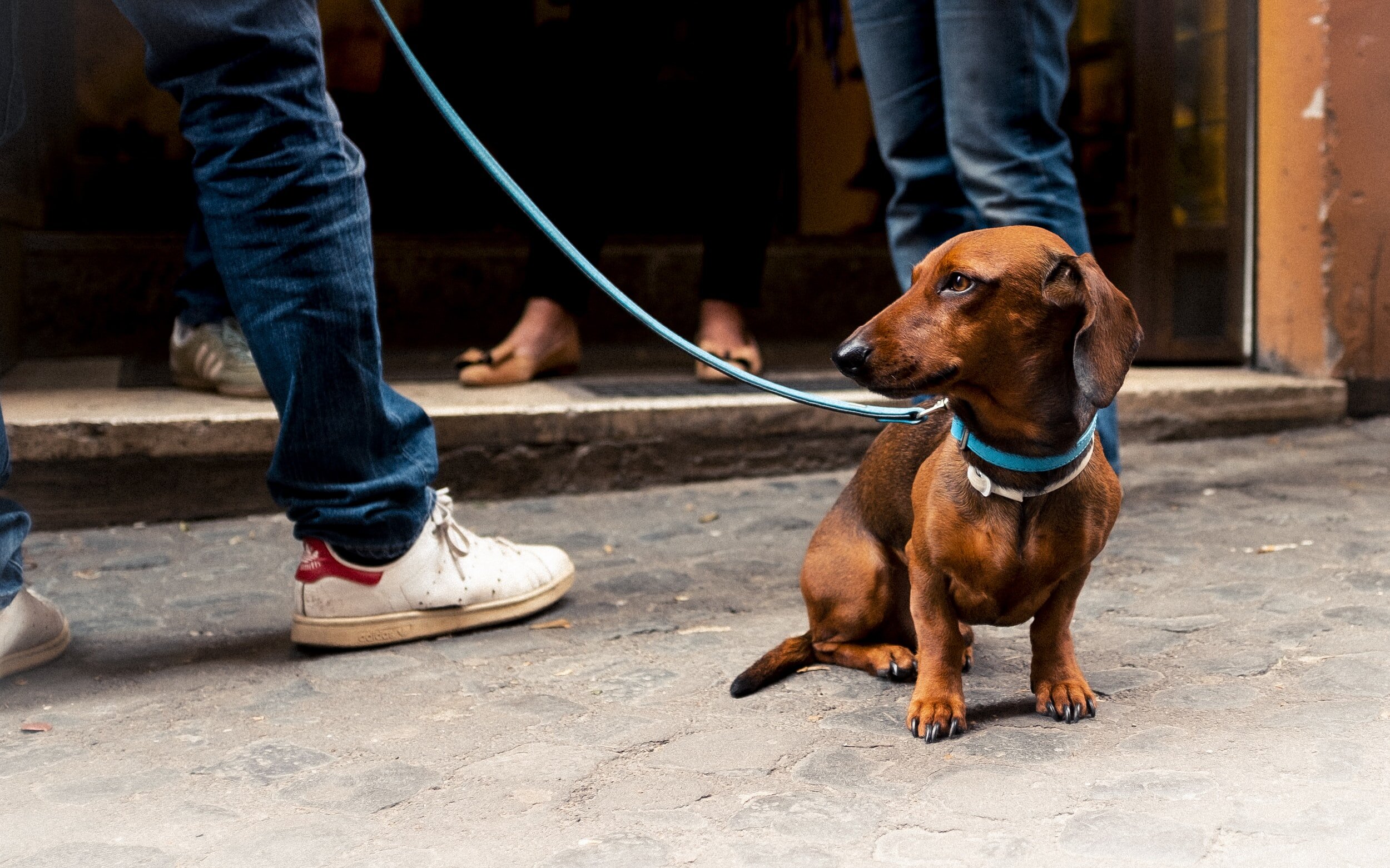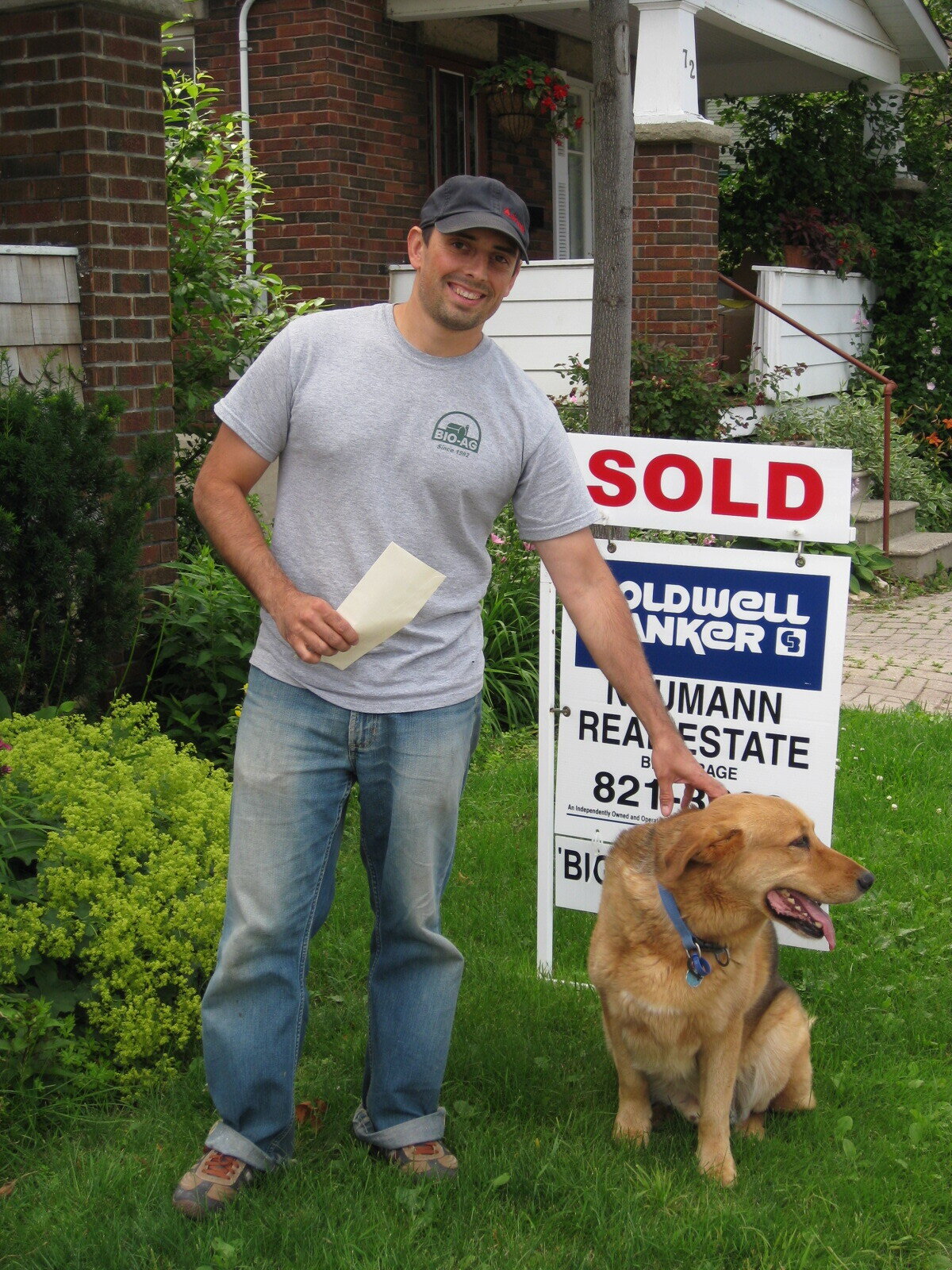This is a leash. Long lines are usually 15 feet long (or longer) Who could resist this adorable photo?!
(Photo: terrier chases a ball while wearing a blue harness and a long line)
A long line is a lightweight, long leash which is often used in off-leash training. They range from 15 feet to roughly 30 feet and usually have no handle (which prevents them from getting caught on shrubs and tree roots.)
I’ve been researching long lines this month and thought it would be valuable to share what I’ve learned with you.
First of all, I’ve never owned a long line. To teach recall, I’ve always used a combination of indoor practice (on and off leash), outdoor practice on leash, play (fetch), and because I like to save money, tying two leashes together to make a makeshift long line.
I absolutely love research, so I’ve been reading about long lines all month.
Here’s what I’ve learned from Canadian dog lovers and trainers around the globe.
To DIY or not DIY? That is the question. (Photo: a dirty, braided rope snagged on a log)
Long lines range in price, quality, and fabric. We’re going to dive into the pros and cons of the different fabrics, so that you can choose the option that works best for you and your dog.
NYLON:
You can get nylon long lines at Dollarama. While they are obviously not going to last as long or be as well-made as some options, they have great reviews from people with dogs weighing under twenty pounds.
Drawbacks: The clips are not as strong. The lines are not easy to clean when they get wet/muddy etc. The nylon tends to attract burrs and other debris.
You can buy nylon long lines with better clips from most pet stores for around $30 CAD + HST.
Nylon gets wet, dirty, and can attract burrs and debris (Photo: poodle wearing a red nylon leash)
BIOTHANE:
BioThane® is the brand name of all coated webbing products made by BioThane Coated Webbing Corp. It’s basically a polyester webbing with a TPU or PVC coating that makes it more durable, waterproof, easy to clean and even weldable. BioThane® has suddenly become the go-to choice for dog collars, leashes, and even long lines. It comes in lots of bright, fun colours making it very popular with dog owners.
On the high end, you can purchase a 20 foot BioThane® long line for $60 CAD + HST.
There are more cost effective BioThane® long line options. Hunting stores sell BioThane® long lines which are interestingly cylindrical rather than flat. Made for dogs who run through the brush during long hunting trials, you know they’ll work for you and your dog on any trail. They also roll up small enough to fit in a coat pocket. A 20 foot long line from Canadian Gun Dog Supply costs $30 CAD + HST.
Biothane is easier to clean and comes in a wide selection of colours (Photo: Dachshund wearing a turquoise collar and leash)
DIY (MAINLY MADE OF ROPE): I love a good DIY and thought that this would definitely be the option for me, until I read all of the reviews online. Many people head to the local hardware store to make their own long lines. While this will certainly save you money, many of the ropes will easily snag on brush and trees. Long lines made from rope also attract burrs and tend to get tangled, causing dog owners to get very frustrated.
Rope tends to attract burrs as well as getting tangled and dirty (Photo: dirty, fraying rope)
HORSE LUNGE LINES:
Horse lunge lines are also very popular with dog owners. They are often cheaper than nylon long lines sold in pet stores and have high quality clips.
They fall short in the easy-to-clean category and also tend to get tangled.
If you don’t mind untangling things, you can get a horse lunge line for approximately $10-20 CAD + HST.
Horse lunge lines are an outside-the-box affordable option (Photo: two women stand with a horse and dog (both on lead)
After reading about all of the tangled lines, burrs, and wet/muddy lines, I opted for BioThane® for my long line. Hunters spend long hours in the bush in all sorts of weather. If it’s strong enough to stand up to a gun dog racing through the brush, it’ll be strong enough for dog training.
PARACHUTE CORD: Parachute cord is wonderful for the final stages of transitioning your dog to off-leash life. It is so lightweight that your dog will feel as though he’s truly off-leash, but you have the ability to control him (he just doesn’t know it.)
Parachute cord needs to be stepped on, rather than grabbed with your hand. If you tie knots in the cord every few feet, it will be easier for your shoe to actually catch the cord as it moves along the ground.
You can purchase 50 feet of parachute cord for $7 + HST at Home Depot. You’ll want to buy bolt snaps so that you can easily attach it to your dog’s collar. At Home Depot they are sold in two packs and cost $3.95 + HST.
Canadian Tire and Home Depot have both stopped selling rope on spools. That’s why my price is for 50 feet of parachute cord — it’s prepackaged (at Home Depot) and only comes in one length.
Canadian Tire doesn’t sell parachute cord in their stores at this time.
I had to include this because I love slack-lining :) This is not parachute cord. (Photo: a person slack-lining over a canyon)
A quick note on safety:
I would not recommend leaving a long line on your dog while on an off-leash hike where they may get snagged or tangled with other dogs who you don’t know. Instead, use a long line to train reliable off-leash recall in your home, backyard, or empty field.
The take home message is that long lines are for TRAINING not for passively allowing your dog to race through the bush tangling up every dog they meet along the way. Tangled dogs and leash tension start fights. Be safe out there.
Have a safe and happy weekend, Dog Leaders. Remember to keep enjoying the things you CAN do (walking your dog, training your dog, reading, exercising etc,) rather than focusing on the next lockdown.
For those of you who don’t know, Ontario is heading into another lockdown, beginning on Saturday, April 3, 2021.
Keep shining your lights and spreading kindness, friends. We’ll get through this.
Alyssa
Photos by: Aaron Clinard @aaronclinard (terrier chases a ball while wearing a blue harness and a long line,) vijay s @thevijayragav (a dirty, braided rope snagged on a log,) Bianca Ackermann
@biancablah (poodle wearing a red nylon leash,) William Fonteneau
@williamfntn (Photo: Dachshund wearing a turquoise collar and leash,) Nick Wood
@thewhitewood (dirty, fraying rope,) courtney coles
@kernieflakes (two women stand with a horse and dog (both on lead,) Loic Leray
@loicleray (a person slack lining over a canyon.)




















































